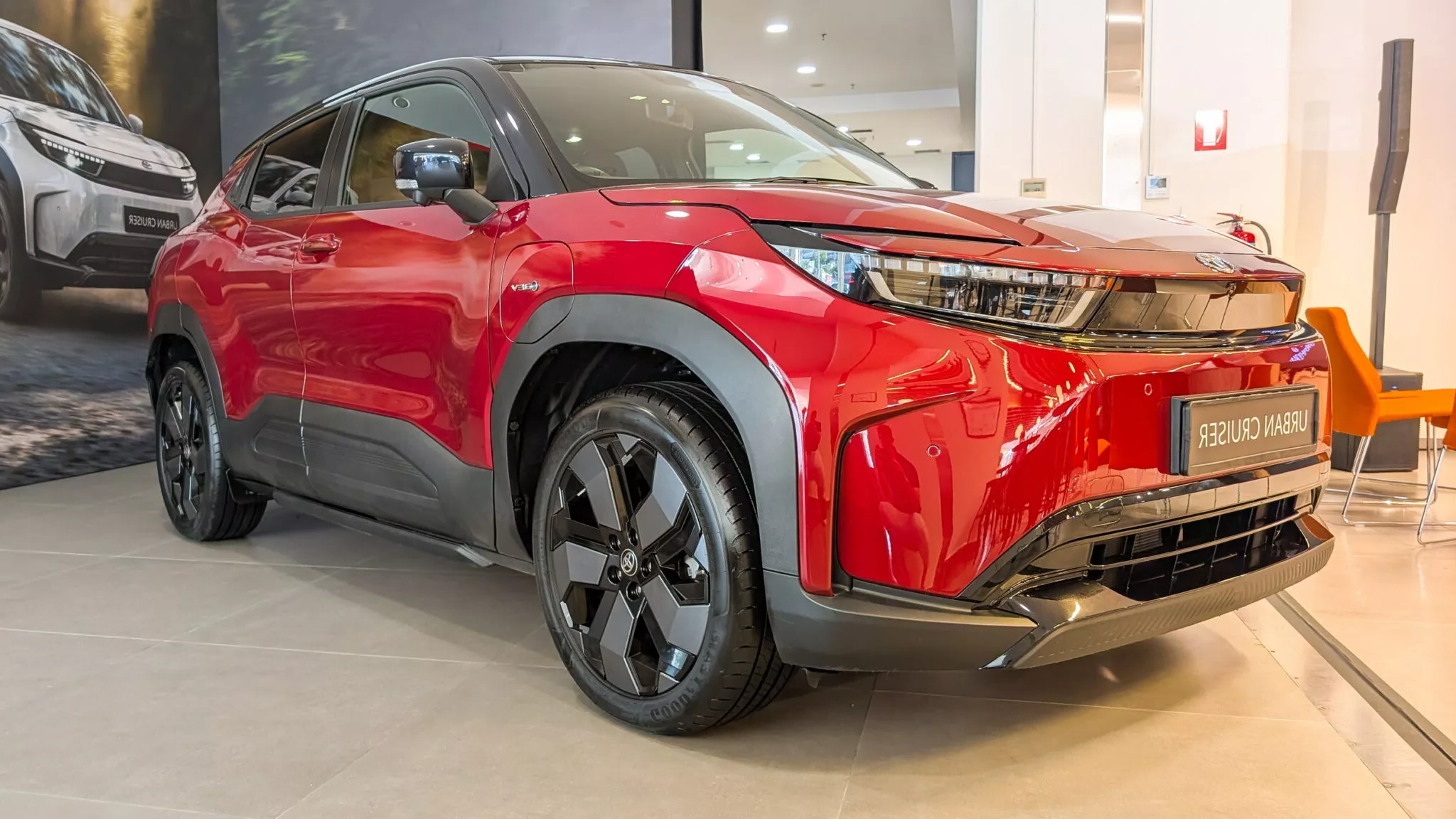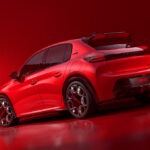Toyota is strategically advancing its comprehensive “multi-pathway strategy in Europe,” a nuanced approach to sustainable mobility that recognizes the diverse needs of consumers and the varied infrastructure readiness across different regions.
This strategy involves not only the continued refinement and expansion of its highly successful hybrid offerings but also a gradual yet determined build-out of its all-electric vehicle (EV) lineup. This balanced approach ensures that Toyota can cater to a broad spectrum of environmental considerations and market demands.
Recently, during an exclusive presentation held in Greece, automotive enthusiasts and media representatives were granted a privileged “early look at three upcoming models.” These vehicles are poised to significantly bolster Toyota’s presence in the European market later this year, reinforcing the brand’s commitment to electrified mobility.
The trio showcased included the “refreshed bZ4X,” an updated version of their established electric SUV; the all-new “C-HR+,” which hints at an expanded and potentially more premium offering; and the much-anticipated “all-electric Urban Cruiser.” All three models are slated to begin their journey onto “European roads later this year,” marking a pivotal moment in Toyota’s electrification roadmap for the continent.
Among this exciting lineup, it was the “smallest one that stood out” for its intriguing origins and unique positioning. The Urban Cruiser, which made its global debut in December 2024, represents Toyota’s latest strategic entry into the highly competitive B-SUV (subcompact SUV) segment.
This category is characterized by its popularity in urban environments, offering a blend of compact dimensions with the practicality and elevated driving position of an SUV. Specifically developed to cater to the preferences and requirements of “European buyers,” this compact yet versatile EV is scheduled to “begin reaching customers in autumn 2025.” Its introduction is expected to further diversify Toyota’s electric offerings and capture a significant share of the rapidly growing subcompact EV market in Europe.
Unveiling the Urban Cruiser’s Suzuki Heritage
While the new Toyota Urban Cruiser proudly bears the Toyota badge and aims to serve as an electric counterpart to the successful Yaris Cross Hybrid, a closer inspection reveals a fascinating underlying truth: the “similarities end with the badge.” Beneath its subtly revised exterior, the Urban Cruiser conceals its shared genetic makeup, fundamentally differing from Toyota’s own well-known architectures. This distinction is crucial to understanding its unique market positioning and development.
Instead of riding on Toyota’s proprietary e-TNGA architecture, which underpins other Toyota electric vehicles like the bZ4X, the Urban Cruiser is built upon “Suzuki’s Heartect-e platform.” This dedicated EV platform is also shared with Suzuki’s upcoming all-electric SUV, the eVitara, indicating a strategic collaboration between the two Japanese automotive giants.
This partnership allows Toyota to rapidly expand its EV portfolio in segments where it might not yet have a bespoke electric platform ready, leveraging Suzuki’s expertise in compact vehicle development. The result of this collaboration is evident in more than just the underlying platform; “much of the exterior and interior design also mirrors the Suzuki,” with only “minor tweaks to differentiate the two” brands’ offerings. This approach streamlines development and manufacturing, allowing both companies to bring electric vehicles to market more efficiently.
Despite the strong visual and structural ties to its Suzuki sibling, Toyota has successfully imparted its own distinctive identity to the Urban Cruiser, particularly at the front. Toyota has added “its own identity through a hammerhead-style lighting signature,” a contemporary design cue that aligns the Urban Cruiser with other newer Toyota models and gives it a recognizable face. This distinctive lighting, coupled with a “more refined bumper design,” contributes to a sleeker and more cohesive aesthetic. These design modifications are deliberate, aiming to give the Urban Cruiser a “cleaner, more cohesive look compared to its Suzuki twin.”
The changes, while subtle in the grand scheme of the vehicle’s body, are impactful enough to distinguish the Toyota variant. Apart from these front-end enhancements and the prominent “Toyota’s emblems,” as well as updated “new taillight graphics,” the remaining “body panels are essentially unchanged” from the Suzuki eVitara. This strategic differentiation allows each brand to appeal to its respective customer base while benefiting from shared development costs.
Interior Design and Practicality: Space Over Opulence
Despite its direct lineage from Suzuki, the Urban Cruiser’s interior and overall design align remarkably well with Toyota’s contemporary design language. The vehicle presents a robust and confident stance, characterized by its “chunky front end, muscular fenders, and darkened taillight cluster.” These elements contribute to a cohesive aesthetic that feels distinctly Toyota, despite the underlying shared platform. Its dimensions position it squarely within the competitive B-SUV segment.
The SUV measures “4,285 mm (168.7 inches) in length,” which strategically places it between Toyota’s existing subcompact SUV, the 4,180 mm (164.6 inches) Yaris Cross, and the slightly larger compact SUV, the 4,360 mm (171.7 inches) C-HR. This precise sizing ensures it fills a specific niche within Toyota’s diverse SUV lineup, catering to urban dwellers who need a compact footprint but desire SUV versatility.
However, a key advantage of its electric powertrain and dedicated platform becomes apparent in its interior packaging. The Urban Cruiser boasts an impressive “EV-specific packaging” that allows for a “2,700 mm (106.3 inches) wheelbase.” This is a critical dimension because it is “longer than both of those models (Yaris Cross and C-HR), as well as the larger Corolla Cross.” A longer wheelbase typically translates directly into more interior space, especially for passengers, which is a significant selling point in this segment.
This “extra length pays off inside,” particularly for those in the rear seats. Rear passengers will find “generous legroom,” a notable improvement over many subcompact SUVs. Furthermore, the inclusion of a “sliding bench” in the rear allows for flexible cabin configuration, enabling users to prioritize either passenger comfort or cargo space as needed. These features collectively contribute to making the “cabin feel roomier than the Yaris Cross,” enhancing the overall passenger experience.
That said, it’s worth noting that “headroom in the back is more limited,” which might be a consideration “particularly for taller occupants.” This slight compromise is largely due to the vehicle’s design and the strategic placement of its core components. The “fixed sunroof and the floor-mounted battery take up vertical space,” which can impact headroom for those who prefer sitting upright or are above average height.
As anticipated, given its shared platform, the “rest of the interior is virtually identical to the Suzuki eVitara.” Toyota’s influence within the cabin is primarily “limited to the emblem on the steering wheel and the Urban Cruiser lettering on the floor mats.” This minimalist approach to differentiation underscores the collaborative nature of the vehicle’s development. Despite the extensive use of shared components, the “perceived quality is not bad,” indicating that Suzuki’s Heartect-e platform prioritizes durable and well-assembled materials, even if “liberal use of hard plastics” is evident. While hard plastics are common in this segment to manage costs, their texture and finish can greatly influence the perceived quality.
Personal preferences regarding interior aesthetics will vary, but certain design choices stand out. The “glossy black finish of the floating center console” might not appeal to everyone due to its propensity to attract fingerprints and dust. However, the cabin benefits from modern touches such as “ambient lighting,” which adds a sophisticated glow, and “unusual texture on the door cards,” providing a tactile and visually interesting element. The “seat upholstery also looks pretty modern,” contributing to an inviting and contemporary interior ambiance.
For those who prefer tactile controls over purely digital interfaces, there’s good news: “Luckily, there are a few physical controls under the digital cockpit.” This digital cockpit itself is impressive, comprising a “10.25-inch instrument cluster” for driver information and a “10.1-inch infotainment” screen for multimedia and navigation, offering a modern and connected user experience.
Powertrain and Performance: Efficiency and Range
Underneath its shared bodywork, the Toyota Urban Cruiser directly inherits its powertrain options from the Suzuki eVitara, offering a versatile range of configurations to suit different driver needs and preferences. This commonality streamlines production and ensures a consistent performance baseline across both models. Buyers will have the flexibility to “choose between two battery capacities and three drivetrain options,” allowing for customization based on their driving habits and desired range.
The front-wheel drive (FWD) version equipped with the larger 61 kWh lithium-iron phosphate battery is projected to deliver a substantial targeted WLTP range of “around 400 km (249 miles).” This is a competitive range for a B-segment EV, making it suitable for both urban commutes and longer journeys without frequent charging stops.
The use of lithium-iron phosphate (LFP) batteries is a notable choice, as these typically offer greater longevity, enhanced safety, and are often more cost-effective to produce compared to other lithium-ion chemistries, aligning with Toyota’s focus on practicality and mass-market appeal. This particular FWD variant is expected to produce approximately 172 hp (128 kW / 174 PS), providing ample power for nimble urban driving and comfortable highway cruising.
For those requiring enhanced traction and performance, an all-wheel drive (AWD) setup is available. This configuration features a “dual-motor” system, which significantly increases the overall output to “182 hp (135 kW / 184 PS).” While offering superior grip and acceleration, especially in challenging weather conditions or light off-road scenarios, the estimated range for this AWD variant drops slightly to “about 350 km (217 miles).” This slight reduction in range is typical for AWD electric vehicles due to the added weight and energy consumption of the second motor. The dual-motor system also features intelligent power distribution, ensuring optimal traction and stability across various driving surfaces.
In addition to these, there’s also a base FWD version with a smaller 49 kWh battery, which is expected to offer an approximate WLTP range of 300 km (186 miles) and produce 142 hp (106 kW / 144 PS). This entry-level option provides a more affordable entry point into the Urban Cruiser lineup, ideal for urban use where shorter ranges are perfectly adequate.
Here’s a quick overview of the expected specifications:
| Drivetrain | Battery | Output | Target WLTP Range |
| FWD | 49 kWh | 142 hp (106 kW / 144 PS) | approx. 300 km |
| FWD | 61 kWh | 172 hp (128 kW / 174 PS) | approx. 400 km |
| AWD | 61 kWh | 182 hp (135 kW / 184 PS) | approx. 350 km |
The real-world driving experience will be the ultimate test of these figures. “We’re looking forward to seeing how these figures translate to real-world driving once we get behind the wheel.” Factors such as driving style, external temperature, and terrain can influence actual range, making real-world testing crucial for a comprehensive assessment of the Urban Cruiser’s performance and efficiency.
The Land Cruiser Nod and Off-Road Aspirations
The choice of the name “Urban Cruiser” for Toyota’s newest compact EV is undoubtedly a clever and “playful nod to the Land Cruiser,” one of the brand’s most iconic and revered off-road vehicles. This naming strategy evokes a sense of ruggedness and adventure, injecting an “off-road spirit in a much smaller package.”
While no one expects the Urban Cruiser to conquer extreme terrains like its legendary namesake, Toyota subtly reinforces the Urban Cruiser’s “light off-roading potential” through the inclusion of specific features. These include “Downhill Assist Control” and “Trail Mode for slippery surfaces,” functionalities typically found in more capable SUVs. These features suggest that the Urban Cruiser is designed to handle challenging urban conditions, such as steep descents or unpaved roads, and perhaps even some very mild off-road excursions.
However, it’s important to maintain realistic expectations. Despite these features, “no one expects the eVitara-based EV to be as capable as a Suzuki Jimny (never mind the Land Cruiser) off the beaten track.” The Suzuki Jimny, a notoriously capable compact off-roader, sets a very high bar for smaller vehicles, and the Urban Cruiser’s primary design focus remains urban and light suburban environments. The inclusion of the “Cruiser” moniker is more about brand association and a hint of versatility rather than true hardcore off-road prowess.
Interestingly, for those who do require more serious off-road capabilities in a smaller package, “Toyota is working on a baby Land Cruiser” specifically designed for such demanding applications, further highlighting its multi-faceted approach to SUV development.
This isn’t the first instance of Toyota utilizing the “Urban Cruiser name.” Its history dates back to 2006, when it first debuted as a concept vehicle. This was followed by a production model based on the Yaris, which was sold in Europe from 2008 to 2014. That earlier iteration of the Urban Cruiser also had a twin in North America, where it was marketed as the Scion xD.
More recently, the Urban Cruiser name has appeared in global markets for Suzuki-built models, “mostly aimed at India and other emerging regions.” This demonstrates Toyota’s strategy of adapting its naming conventions and product offerings to suit diverse regional markets and partnership dynamics. The revival of the Urban Cruiser name for this new electric B-SUV in Europe signifies its importance in Toyota’s current electrification push.
Toyota’s Expanding European EV Portfolio
The Urban Cruiser is far from being a standalone initiative; it represents just one crucial component of “Toyota’s growing electric strategy in Europe.” The brand is committed to a rapid expansion of its zero-emission vehicle options to meet increasingly stringent environmental regulations and evolving consumer preferences across the continent. This commitment was clearly demonstrated during the same event in Greece, where the Urban Cruiser was presented alongside other key upcoming models.
Among these was the “facelifted bZ4X,” which in North America is simply known as the bZ. This updated electric SUV brings improvements in range, charging, and possibly performance, making it a more compelling offering in the mid-size EV SUV segment. Also showcased was a “prototype of the C-HR+,” which hints at an all-electric version of the popular C-HR, but with enhanced features and potentially a more spacious interior, denoted by the “+”.
Both the refreshed bZ4X and the C-HR+ are “expected to launch in 2025,” indicating a busy year for Toyota’s electric portfolio. While they “share some design language at the front,” notably the “hammerhead” styling cues, “each model serves a different purpose” and targets distinct market segments.
The C-HR+ “leans into a more upscale and sporty image,” characterized by its “coupe-like roofline and sharper styling.” This aesthetic positions it squarely “at the heart of the C-SUV (compact) segment,” appealing to buyers who prioritize distinctive design and dynamic performance. Although it “shares a few cues with the standard C-HR,” the “+” variant is “noticeably larger and bolder,” signifying its unique identity within the lineup. In contrast, the “refreshed bZ4X keeps things more family-friendly” and also adds “some light trail capability thanks to its Subaru-sourced X-Mode AWD system,” emphasizing its versatility and robustness for varied driving conditions.
Looking ahead, Toyota plans to further “round out its European EV portfolio next year with the bZ Woodland,” which is described as a “sibling to the Subaru Trailseeker.” This addition will further diversify Toyota’s electric SUV offerings, likely focusing on even more adventurous capabilities. This rapid expansion will bring the “total to four electric models in the region,” effectively “quadrupling Toyota’s zero-emission options in just two years.” This aggressive timeline underscores the brand’s serious commitment to the European EV market.
While having four distinct EVs in Europe might seem like a substantial lineup, especially for a company whose president has “openly questioned their environmental benefits” in the past (advocating for a broader multi-pathway approach), it’s worth noting that “some markets are getting even more options.” For instance, “China, for example, offers five electric Toyotas: the bZ3, bZ3X, bZ4X, bZ5, and bZ7.” This demonstrates Toyota’s adaptive strategy, tailoring its EV offerings to specific regional demands and regulations.
North America is also expected to eventually “match that number,” though with a potentially different mix of models. US buyers, for example, are anticipated to have access to the C-HR+, bZ, bZ Woodland, and an upcoming three-row SUV that will be built locally, further cementing Toyota’s commitment to expanding its electric presence across key global markets. This multifaceted approach ensures that Toyota remains a formidable player in the evolving landscape of sustainable mobility.








